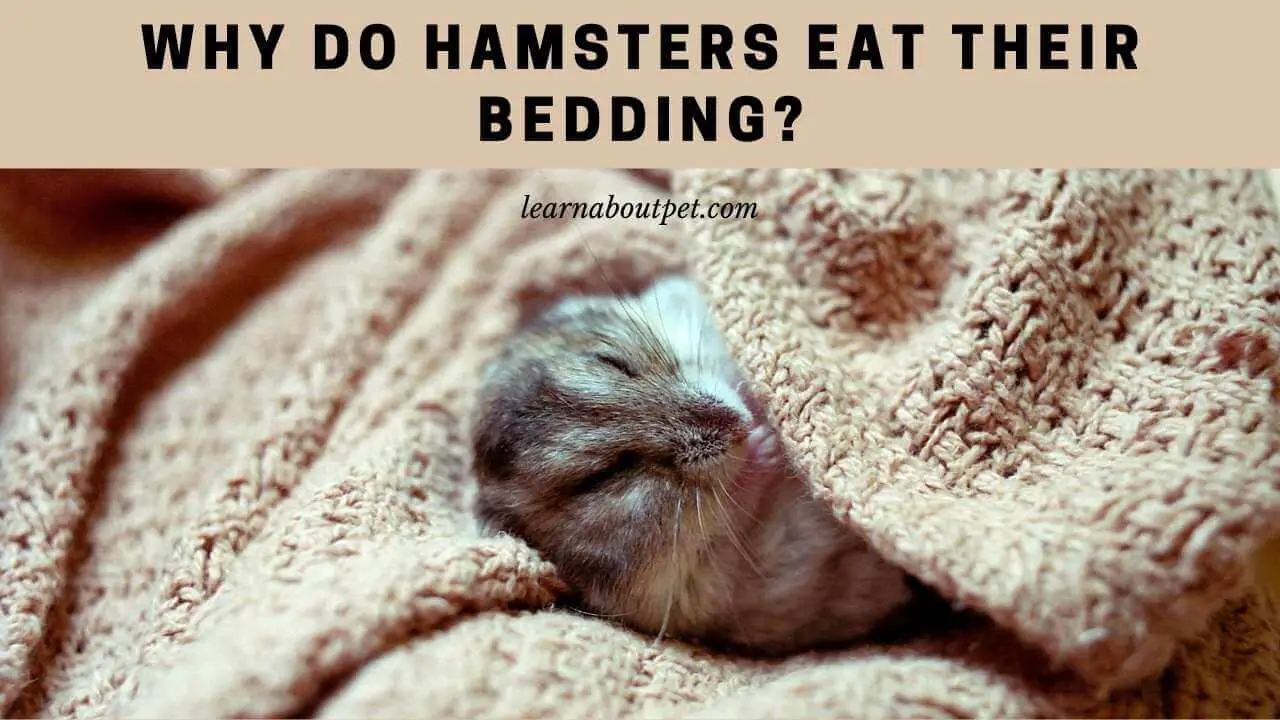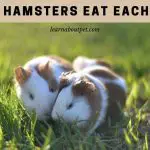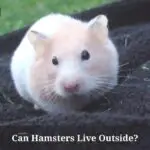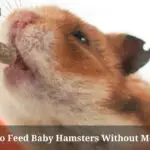Learning that your hamster has been eating his bedding can get the alarm bells in your mind ringing. You will certainly have questions like why is my hamster eating her bedding, whether it is safe, whether it is normal, and how you can stop it.
Why do hamsters eat their bedding? Well, what looks like ‘eating’ actually tends to be stuffing in cheek pouches. Thus in most cases, you find that the hamster is stuffing the bedding in the cheek pouches with a view to transport it elsewhere, and make a nest with it. It is a normal and typical behavior for hamsters. It shouldn’t cause you unnecessary concern.
Thus, when the hamster takes the bedding into his mouth, he will typically not swallow it fully. Instead, he just moves it to his cheek pouches. Then he carries it to the spot that he has selected for nesting, and uses it to create a nest. Or if he already has a nest, he uses it to make the nest more comfortable.

But there are also a few cases where the hamster may be seen actually nibbling at the bedding material with his teeth. In such cases, he would be doing it for the purpose of trimming his teeth so that they don’t overgrow (as they are continuously growing).
In this article, we tackle this issue of hamsters eating their bedding in a comprehensive manner.
Can Hamsters Eat Bedding?
Before turning to the main question on why do hamsters eat their bedding, it is important to first of all find out if they are capable of eating the bedding. So, can hamsters eat bedding?
Yes, it is possible for hamsters to eat bedding. Their teeth are capable of gnawing on the common bedding materials. And after chewing on the bedding materials, they are capable of swallowing them. Thus, hamsters can eat bedding. And as long as the bedding is not made from toxic materials, the hamsters wouldn’t suffer much harm from eating it. That is why we are always advised to ensure that hamster bedding is made from non-toxic materials.
In most cases though, where the hamsters seem to be ‘eating’ the bedding, you come to realize that they are not actually swallowing it fully. Instead, they are just pouching it in their cheeks. You see, hamster’s cheeks have pouches – which they use to transport and sometimes store stuff temporarily.
Is It Normal For Hamsters To Eat Their Bedding?
Related to the question on why do hamsters eat their bedding is the one on whether it is normal/OK for them to do so. So, indeed, is it ok for hamsters to eat their bedding? The answer is yes. It is quite normal for hamsters to eat their bedding.
Where the hamsters actually nibble on the bedding, it would be as part of their effort to keep their teeth trim. This is OK, and actually necessary for them. If they don’t keep their (continually growing) teeth size in check, there would be a risk of the teeth growing beyond their mouths! So they keep them trim by nibbling on hard things: which may include their bedding materials.
Where the hamsters seem to be eating the bedding, but actually just stuff it in their cheek pouches, it would be for nest building purposes. This too would be within the realm of what we view as normal hamster behavior. And it is OK for them too.
Is It Safe For Hamsters To Eat Their Bedding?
Another extension to the question on why do hamsters eat their bedding is on whether it is safe for them to do so. The people posing this question typically have major safety concerns. So, in other words, they seek to know: is it bad if hamsters eat their bedding (from a safety perspective)?
It is usually safe for hamsters to eat their bedding. The only time when it may be unsafe is if the bedding materials are toxic. For instance, if it is pine or cedar shavings bedding we are looking at, it may contain phenols. And the phenols in question can cause considerable respiratory problems for the hamsters.
Another instance where hamster bedding eating may be harmful is where the bedding material happens to be in the form of newspaper shreds. Those obviously have ink on them. And the ink is likely to have heavy metals in it. Those are heavy metals that can, in the long run, cause the hamsters major health problems.
In normal cases though, where the hamsters eat bedding made using safe materials, they suffer no harm.
| Ideal Materials For Making Hamster Bedding |
|
| Materials That Are Not Ideal For Making Hamster Bedding |
|
Why Do Hamsters Stuff Their Cheeks With Bedding?
Hamsters usually stuff bedding in their cheeks with the intention of using it to build nests. Or with the intention of using it to make their nests more comfortable (if they have already built them).
By the way, most of the people who pose the question on why do hamsters eat their bedding turn out to be folks who only saw the rodents stuffing the bedding in their pouches. So they mistake the stuffing for eating. This leads them to ask why do hamsters eat their bedding. In actual fact though, the hamsters are not eating their bedding. They are only stuffing it into their pouches, for use in nest building later.
Can Hamsters Suffocate In Bedding?
The likelihood of hamsters suffocating in bedding is rather low. These, after all, are rodents with very good ability to burrow. Therefore in normal bedding (made from wood shavings or paper shreds), they would be very unlikely to suffocate. Of course, if you provide nylon paper or plastic bedding for your hamster, that is a different matter altogether. He may attempt to burrow in the nylon or plastic, entangle, and actually end up suffocating.
Why Is My Hamster Eating Her Paper Bedding?
He is most probably stuffing the paper bedding into his cheek pouches, rather than actually eating it. Of course, if you don’t look keenly at what he is doing, it can be very easy to mistake cheek stuffing for eating.
So he is stuffing the paper bedding into his cheek pouches, so as to use it to make a nest later. Or if he already has a nest, he just wants to make it more comfortable. After stuffing the paper bedding into his cheek pouches, he will carry it to the nest site, and lay it there.
What Are The Health Symptoms If Hamster Ate Bedding?
If the bedding was made out of non-toxic materials, there probably won’t be any symptoms. The hamster will be just fine. But if, for instance, it is pine or cedar shavings bedding we are talking about, there may be respiratory problems. That is because such woods (pine and cedar) contain phenols, which can cause respiratory problems in hamsters.
If the bedding material was too contaminated with urine (and other forms of dirt), the hamster may experience stomach upsets.

But all these usually only apply if the hamster actually swallows the bedding. In most cases, a hamster that appears to be eating bedding is only stuffing it into his cheek pouch. And that distinction is important: because many of the people who pose the question on why do hamsters eat their bedding don’t understand the pouch stuffing phenomenon in hamsters. So the hamster may not have eaten the bedding, but rather just stuffed it into his cheek pouches.
There is of course the very remote possibility of the bedding being stuck in the hamster’s cheek pouch. If that happens, there would be the appearance of neck and head being swollen, with possibly excess saliva production. But to reiterate, this is very rare.
How To Treat If Hamster Ate Bedding?
The most ideal treatment will depend on whether there have been any complications secondary to the hamster eating bedding. If the hamster has eaten bedding, and there have been no bad symptoms thereafter, he is okay. He probably needs no treatment.
But if the hamster ate bedding, and is experiencing stomach upset, you would need to address that. Similarly, if the hamster ate cedar or pine shavings bedding, and he is having respiratory problems, you would need to have a vet treat those.
If the hamster only took bedding into his cheek pouch, but he is unable to get it out (meaning he has an impacted cheek pouch), you will need to help him get it out. Or take him to a vet for a procedure to remove the bedding that is sticking in the cheek pouch.
How to Prevent Hamster From Eating Bedding Again?
After dealing with the question on why do hamsters eat their bedding, we can now turn to the aspect of prevention. So how do you prevent hamster from eating bedding again? Well, if it is with regard to the aspect of hamsters gnawing on bedding for purposes of trimming their teeth, there is something you can do. And that is to provide them with something better – like a wooden chew toy – to gnaw on.
If the hamster ate bedding and ended up suffering nasty symptoms, you will need to know why. If, for instance, it is because you were using toxic bedding materials, try to get non-toxic materials going forward. This way, even if he eats the bedding again, he won’t suffer ill health.
For the aspect of hamsters stuffing bedding into their cheek pouches for nest making purposes, there is nothing much you can do. It is normal hamster behavior, and they will keep doing it. Yours is to ensure that you don’t use bedding that can get stuck in the hamsters’ cheek pouches. For instance, avoid cotton bedding.
Can Eating Bedding Kill Hamsters?
It is highly unlikely that eating bedding will kill hamsters. But there are two caveats here. One is if the bedding materials are potentially very toxic to hamsters (like pine and cedar shavings). In those cases, there may be respiratory problems if the hamsters eat the beddings. In the worst scenarios, it can lead to death. The other instance is where the bedding gets stuck in the hamster’s cheek pouch.
In the latter case, you may be looking at a scenario where the hamster has stuffed, into his cheek pouch, bedding made from a material like cotton. That is with the intention of using it in nest building. Then he is unable to get it out. Therefore the hamster develops an impacted cheek pouch, and ends up dying from it…
These are rare scenarios though. If you find your hamster eating bedding, chances are that he will be just fine – it won’t kill him.
Hamster Died With Bedding In Mouth, What To Do?
You may want to find out whether the hamsters death was actually as a result of the bedding in his mouth. Or whether he coincidentally just happened to die with bedding in his mouth. A vet may carry out some sort of postmortem examination, to be sure. Perhaps the hamster died as a result of some other infection. And if you happen to have other hamsters you are keeping, you would need to monitor them closely, lest they die from it too…
Where you are sure that the hamster died directly from an impacted cheek pouch (stuffed with bedding), you may still need further investigations. You will need to know what type of bedding it was (for instance, whether it was one of those that are prone to getting stuck, like cotton). This way, you can avoid using it, for the safety of other hamsters you happen to be keeping.
All in all, having a chat with your vet about a hamster who died with bedding in the mouth may be ideal.
Ultimately, you may decide to give the hamster some sort of burial, to get closure.
Final Verdict – Why Do Hamsters Eat Their Bedding
Why do hamsters eat their bedding? what hamsters do in most cases is stuff their cheek pouches with their bedding, rather than actually eating the bedding. They do so with the intention of transporting the bedding material to their nest sites. Where hamsters actually gnaw their bedding, it is usually for the purpose of trimming their continuously growing teeth.

What you need to do is ensure that the bedding material you provide to your hamsters is non-toxic. This way, even if they gnaw on it and swallow it, they won’t suffer harm. The bedding material also needs to be of a type that is unlikely to get stuck in the hamsters’ cheek pouches.

Welcome to Learn About Pet. My name is Rajkumar Ravichandran and I love all pets, travel, and amazing food. I write about my passion and personal experience caring for multiple pets in this blog! ❤️
Post Disclaimer
DISCLAIMER: THIS BLOG OR WEBSITE, "Learn About Pet", DOES NOT PROVIDE YOU WITH MEDICAL ADVICE AND IS NOT A SUBSTITUTE FOR MEDICAL ADVICE. ALWAYS GET IN TOUCH WITH YOUR PERSONAL VETERINARIAN AND USE INFORMATION HERE AS GENERAL ADVICE.
The information, including but not limited to, text, graphics, images and other material contained on this website are for informational purposes only. No material on this site is intended to be a substitute for professional veterinary advice, food recommendation, diagnosis, or treatment. Always seek the advice of your veterinarian or other qualified health care provider with any questions you may have regarding a medical condition or for pet food related questions.







